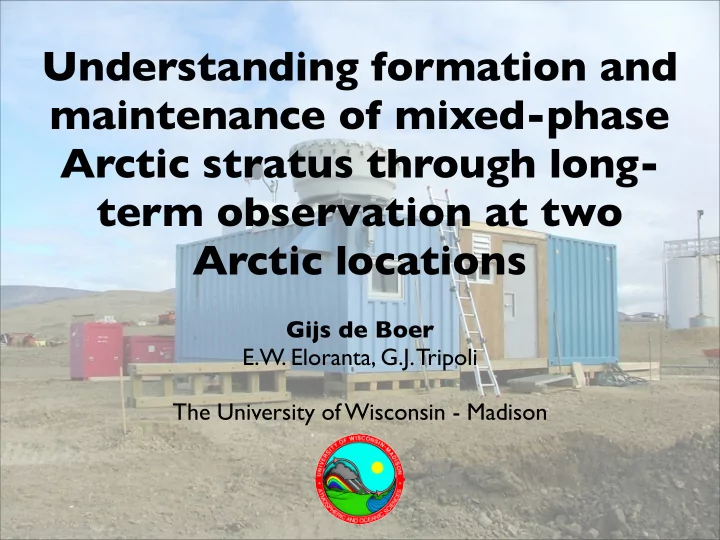

Understanding formation and maintenance of mixed-phase Arctic stratus through long- term observation at two Arctic locations Gijs de Boer E.W. Eloranta, G.J. Tripoli The University of Wisconsin - Madison
Introduction AGU San Francisco, 14 December, 2007
Introduction AGU San Francisco, 14 December, 2007
Introduction These cloud structures are extremely prevalent in the Arctic: - SHEBA: 48% occurrence in May (Rogers et al., 2001) - Low altitude stratus frequency of up to 70% during transitional seasons (Curry et al., 1996; Herman and Goody, 1976) - From Eureka: over 1700 30 minute cases for September 2005-December 2006. - From M-PACE: over 500 30 minute cases for mid September-mid November, 2004. October Single Layer Stratus 1500 Number of Cases 1000 500 0 2004 (Barrow) 2005 (Eureka) 2006 (Eureka) Month AGU San Francisco, 14 December, 2007
Introduction From ARM Model intercomparison (Klein et al.) AGU San Francisco, 14 December, 2007
Introduction From ARM Model intercomparison (Klein et al.) AGU San Francisco, 14 December, 2007
Introduction - Ice Formation (Pruppacher and Klett, 1997) • Homogeneous nucleation • Heterogeneous nucleation • Deposition freezing • Contact freezing • Condensation freezing • Immersion freezing • Some Multiplication Processes • Drop shattering • Ice-ice collisions • Splinter ejection during riming AGU San Francisco, 14 December, 2007
Observations Instruments • UW Arctic High Spectral Resolution Lidar • Microwave Radiometer • NOAA ETL Millimeter Cloud Radar • U. Idaho Polar AERI • 12-hr. Radiosonde Frequency • CALIPSO • In-situ from M-PACE • CloudSAT AGU San Francisco, 14 December, 2007
Observations Where does the ice come from? Low IN, but substantial ice... Example from M-PACE: CFDC Average out of cloud IN concentration for 9 and 10 October 2004: 0.16 1/L Ice particle concentrations: ~10 1/L So nucleation not by: -Deposition freezing -Condensation freezing -Contact freezing alone AGU San Francisco, 14 December, 2007
Observations Radar backscatter cross section (Masked values shown in black and white) Lidar backscatter cross section (Masked values shown in black and white) 1e ! 7 1e ! 3 1e ! 8 4.0 4.0 1e ! 4 1e ! 9 Altitude (km) Altitude (km) 3.0 3.0 1e ! 5 1e ! 10 1e ! 11 2.0 2.0 1e ! 6 1e ! 12 1.0 1.0 1e ! 7 1e ! 13 1e ! 14 1e ! 8 13 13 14 14 15 15 16 16 17 17 18 18 19 19 20 20 21 21 22 22 23 23 1/(m str) 1/(m str) Time (UT) Time (UT) AGU San Francisco, 14 December, 2007
Observations Cloud Mask (Masked values shown in black and white) 1 0.9 4.0 0.8 0.7 3.0 0.6 Altitude (km) 0.5 2.0 0.4 0.3 1.0 0.2 0.1 13 14 15 16 17 18 19 20 21 22 23 Time (UT) AGU San Francisco, 14 December, 2007
Observations Probability Density Function 1 Cloud Min. Temp. Cloud Max. Temp. 0.9 0.8 0.7 Normalized # 0.6 0.5 0.4 0.3 0.2 0.1 0 230 240 250 260 270 280 Temperature (K) AGU San Francisco, 14 December, 2007
Observations Probability Density Function 1 (Hagen et al., 1981; Jensen et al., 1998) Cloud Min. Temp. Homogeneous Freezing (< -35°C) Cloud Max. Temp. 0.9 0.8 0.7 Normalized # 0.6 0.5 0.4 0.3 0.2 0.1 0 230 240 250 260 270 280 Temperature (K) AGU San Francisco, 14 December, 2007
Observations Probability Density Function 1 (Hagen et al., 1981; Jensen et al., 1998) Cloud Min. Temp. Homogeneous Freezing (< -35°C) Cloud Max. Temp. 0.9 (Heymsfield and Mossop, 1984) 0.8 Splinter Ejection (> -8°C) 0.7 Normalized # 0.6 0.5 0.4 0.3 0.2 0.1 0 230 240 250 260 270 280 Temperature (K) AGU San Francisco, 14 December, 2007
Observations 20 15 10 (T cb ! T s*c )/ ! < (7/km) 5 0 ! 5 ! 10 230 235 240 245 250 255 260 265 270 )*c. Tem1erature (7) AGU San Francisco, 14 December, 2007
Observations Why the horizontal variability in ice production? AGU San Francisco, 14 December, 2007
Observations Why the horizontal variability in ice production? Figures courtesy of M. Shupe (NOAA) AGU San Francisco, 14 December, 2007
Summary Ice production likely not due to: - Homogeneous Nucleation (too warm) - Condensation, deposition or contact freezing alone (too few IN) - Drop splinter ejection during riming (too cold) AGU San Francisco, 14 December, 2007
Summary Ice production likely not due to: - Homogeneous Nucleation (too warm) - Condensation, deposition or contact freezing alone (too few IN) - Drop splinter ejection during riming (too cold) Key to understanding ice production: - Likely lies with understanding controlling mechanisms for horizontal variability in observed precipitation AGU San Francisco, 14 December, 2007
Summary Ice production likely not due to: - Homogeneous Nucleation (too warm) - Condensation, deposition or contact freezing alone (too few IN) - Drop splinter ejection during riming (too cold) Key to understanding ice production: - Likely lies with understanding controlling mechanisms for horizontal variability in observed precipitation Future investigation - Numerical sensitivity experiments to look at individual processes. - Evaluate role of vertical velocity in cloud layer AGU San Francisco, 14 December, 2007
Recommend
More recommend